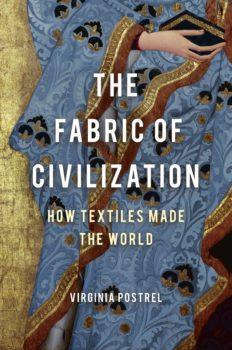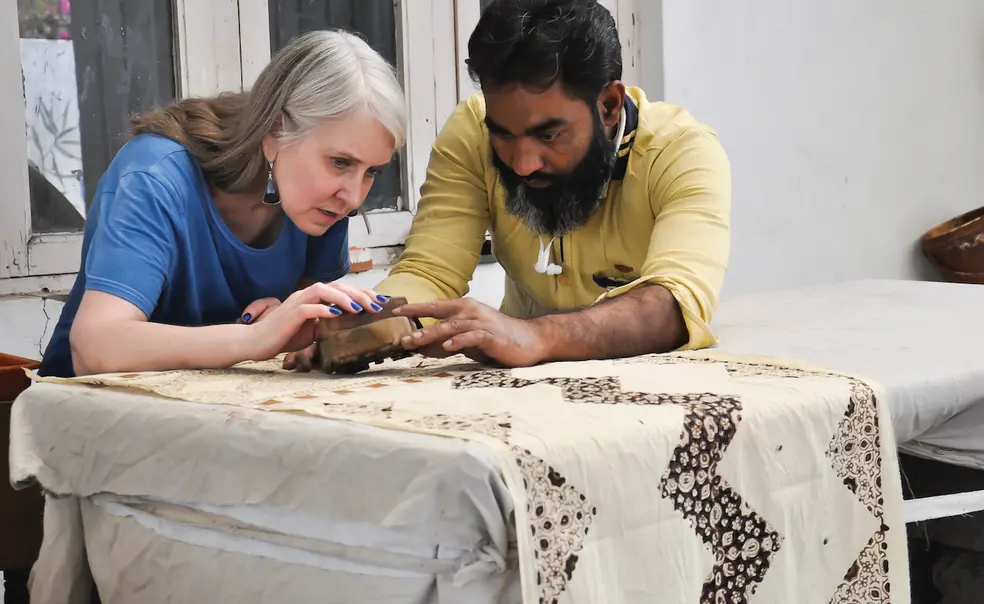Virgina Postrel ’82 Traces the History of Fabrics in Latest Book
‘We don’t think about how central [fabrics] are to our lives’
The next time you pull on your favorite piece of clothing, consider how the material it’s made of can tell the history of the growth and challenges of economies around the world.
That’s what Virginia Postrel ’82 implies when she discusses what drew her to write The Fabric of Civilization: How Textiles Made the World (Basic Books). The Los Angeles-based author and journalist wanted to tell the wider story of textiles playing pivotal roles in civilizations near and far, from the Minoans to the Romans to Silicon Valley.

“We don’t think about how central they are to our lives, how central they’ve been to history and to economics,” says Postrel.
Color dyes, for example, started when Minoans exported wool colored with precious purple dye to Egypt. Soon clothing around the world featured an array of colors. As the book points out, the textile industry funded the Renaissance and the Mughal Empire.
Postrel writes on more advanced techniques, too, such as the breeding of plants and insects that allow for natural fiber, and the creation of synthetic polymer fabrics like nylon.
Postrel has actually long been fascinated by aesthetics. In fact, her 2003 book The Substance of Style: How the Rise of Aesthetic Value Is Remaking Commerce, Culture, and Consciousness, looked at sensory inspirations found in not just fashion, but also tech, real estate, and economics.
“Aesthetics give us pleasure, give us meaning,” she says, pointing to the example of how Starbucks not only leveled up what a coffee could be but also what a café could look and feel like.
Getting theoretical about what we experience every day is a thread running through Postrel’s other work. One example is her 1999 book The Future and Its Enemies: The Growing Conflict Over Creativity, Enterprise and Progress that delved into how “human betterment depends not on conformity to one central vision but on creativity and decentralized, open-ended trial and error,” as the book jacket explains.
“Around that time, as the Internet was coming into its own, I was interested in the conflict between visions of the sort of good society that learns through bottom-up experimentation and feedback versus one that is planned ... [and] possibly backward-looking,” she says.
A native of Greenville, South Carolina, she quickly took to reading and even pored through the encyclopedia often.
“I was interested in history, religion, science, economics, literature,” she says.
Postrel enrolled in Princeton as an English major, but took economics courses as often as she could, and even waffled between the two as majors. What Princeton gave her was a greater sophistication to parse through the ideas that mattered to her then, she recalls.
Immersing herself in economics let her apply her skills at The Daily Princetonian where she worked first as an advertising manager, and then as a writer when her love of journalism began to take hold.
She interned at the Wall Street Journal’s now-defunct Philadelphia bureau and freelanced for Forbes beginning in 1995. But she landed an ideal role for her skill set when she became editor of Reason after spending three years as assistant editor at the magazine.
“That was a hugely important educational experience because in order to edit a magazine like that, you have to read very widely, and you have to know lots of people,” Postrel says. “You have to develop expertise on a huge range of subjects.”
In 2000, she left the magazine after feeling burned out and realizing how cash-poor the magazine had become. She decided to establish herself as an independent author and journalist. It was during an assignment writing on the history and impact of textiles for Aeon magazine that fostered the idea to tackle a longer work on the subject.
Postrel speaks excitedly about what she uncovered during that research process, which took her all over the world and into the labs and homes of textile manufacturers and cloth makers. She cites “the most famous thing in the book” — a chart displaying how long it would take to spin threads in various sized garments. “For example, for the denim for a pair of jeans, weaving that amount of fabric takes about six miles of cotton thread,” she says.
Today she is writing a children’s book she hopes will find a home with a publisher in the coming year. The story would spinoff the central themes and ideas raised in Fabric of Civilization and feature a child or tween protagonists coming from different eras in world history.
Much like how the story of textiles continues to evolve, so too does the journey Postrel is on to continue to spread the gospel about the materials we touch and wear daily.











No responses yet